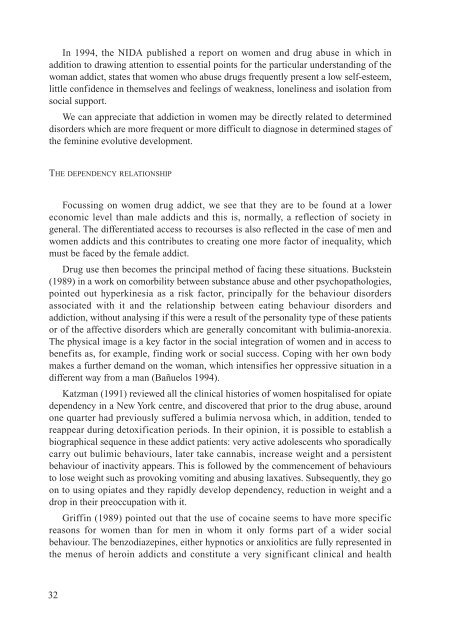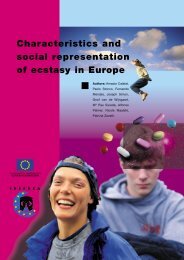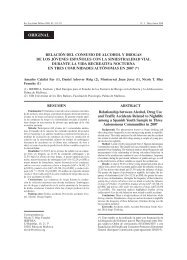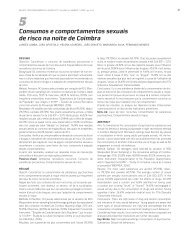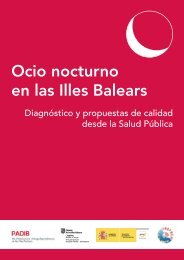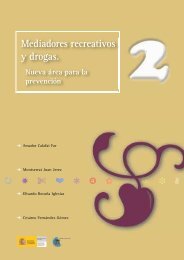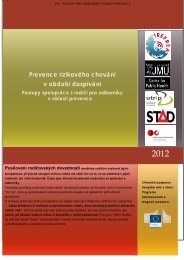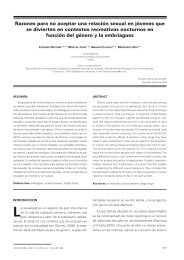Women drug abuse in Europe : Gender identity - Irefrea
Women drug abuse in Europe : Gender identity - Irefrea
Women drug abuse in Europe : Gender identity - Irefrea
You also want an ePaper? Increase the reach of your titles
YUMPU automatically turns print PDFs into web optimized ePapers that Google loves.
In 1994, the NIDA published a report on women and <strong>drug</strong> <strong>abuse</strong> <strong>in</strong> which <strong>in</strong>addition to draw<strong>in</strong>g attention to essential po<strong>in</strong>ts for the particular understand<strong>in</strong>g of thewoman addict, states that women who <strong>abuse</strong> <strong>drug</strong>s frequently present a low self-esteem,little confidence <strong>in</strong> themselves and feel<strong>in</strong>gs of weakness, lonel<strong>in</strong>ess and isolation fromsocial support.We can appreciate that addiction <strong>in</strong> women may be directly related to determ<strong>in</strong>eddisorders which are more frequent or more difficult to diagnose <strong>in</strong> determ<strong>in</strong>ed stages ofthe fem<strong>in</strong><strong>in</strong>e evolutive development.THE DEPENDENCY RELATIONSHIPFocuss<strong>in</strong>g on women <strong>drug</strong> addict, we see that they are to be found at a lowereconomic level than male addicts and this is, normally, a reflection of society <strong>in</strong>general. The differentiated access to recourses is also reflected <strong>in</strong> the case of men andwomen addicts and this contributes to creat<strong>in</strong>g one more factor of <strong>in</strong>equality, whichmust be faced by the female addict.Drug use then becomes the pr<strong>in</strong>cipal method of fac<strong>in</strong>g these situations. Buckste<strong>in</strong>(1989) <strong>in</strong> a work on comorbility between substance <strong>abuse</strong> and other psychopathologies,po<strong>in</strong>ted out hyperk<strong>in</strong>esia as a risk factor, pr<strong>in</strong>cipally for the behaviour disordersassociated with it and the relationship between eat<strong>in</strong>g behaviour disorders andaddiction, without analys<strong>in</strong>g if this were a result of the personality type of these patientsor of the affective disorders which are generally concomitant with bulimia-anorexia.The physical image is a key factor <strong>in</strong> the social <strong>in</strong>tegration of women and <strong>in</strong> access tobenefits as, for example, f<strong>in</strong>d<strong>in</strong>g work or social success. Cop<strong>in</strong>g with her own bodymakes a further demand on the woman, which <strong>in</strong>tensifies her oppressive situation <strong>in</strong> adifferent way from a man (Bañuelos 1994).Katzman (1991) reviewed all the cl<strong>in</strong>ical histories of women hospitalised for opiatedependency <strong>in</strong> a New York centre, and discovered that prior to the <strong>drug</strong> <strong>abuse</strong>, aroundone quarter had previously suffered a bulimia nervosa which, <strong>in</strong> addition, tended toreappear dur<strong>in</strong>g detoxification periods. In their op<strong>in</strong>ion, it is possible to establish abiographical sequence <strong>in</strong> these addict patients: very active adolescents who sporadicallycarry out bulimic behaviours, later take cannabis, <strong>in</strong>crease weight and a persistentbehaviour of <strong>in</strong>activity appears. This is followed by the commencement of behavioursto lose weight such as provok<strong>in</strong>g vomit<strong>in</strong>g and abus<strong>in</strong>g laxatives. Subsequently, they goon to us<strong>in</strong>g opiates and they rapidly develop dependency, reduction <strong>in</strong> weight and adrop <strong>in</strong> their preoccupation with it.Griff<strong>in</strong> (1989) po<strong>in</strong>ted out that the use of coca<strong>in</strong>e seems to have more specificreasons for women than for men <strong>in</strong> whom it only forms part of a wider socialbehaviour. The benzodiazep<strong>in</strong>es, either hypnotics or anxiolitics are fully represented <strong>in</strong>the menus of hero<strong>in</strong> addicts and constitute a very significant cl<strong>in</strong>ical and health32


